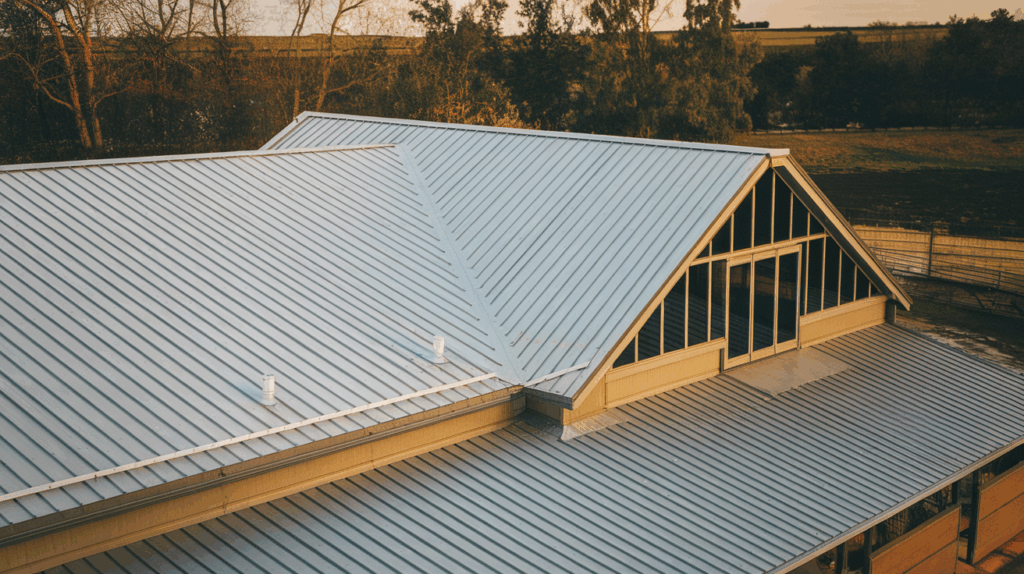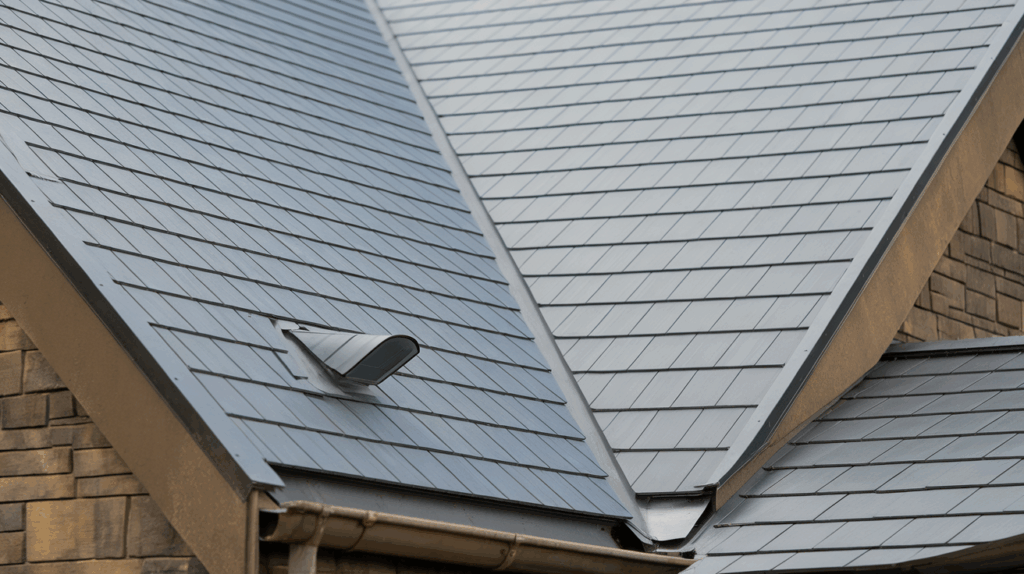When it comes to metal roofing, the pitch of your roof is more than just an aesthetic choice.
It plays a critical role in your roof’s overall performance, longevity, and effectiveness.
Understanding the minimum pitch requirements for metal roofs is essential for ensuring your roof operates as intended, protecting your home from water damage and other elements.
No matter if you’re planning a new metal roof installation or replacing an old one, knowing the minimum pitch and how it affects your roofing system is key.
In this article, I’ll break down why roof pitch matters, the industry standards for metal roofing, and the factors that influence your pitch choice.
Why Roof Pitch Matters
Roof pitch plays a crucial role in the performance and longevity of your roof.
It affects drainage, material lifespan, and overall protection from the elements.
- Better Drainage: Steeper pitches prevent water pooling and snow accumulation.
- Prevents Damage: Insufficient pitch can lead to leaks, rusting, and roof failure over time.
- Increases Longevity: Proper pitch reduces moisture buildup, extending the life of roofing materials.
When you select the appropriate minimum pitch for your metal roof, you ensure that your roof is both functional and long-lasting.
Industry Standards for Metal Roof Pitch
To guide you in making the right decision, it’s important to follow industry standards for roof pitch, which are outlined in the International Building Code (IBC) and the International Residential Code (IRC).
These codes establish the minimum requirements for various roof types, including metal roofs.
In general, most metal roofing systems require a certain slope to ensure proper drainage and water flow.
If your roof doesn’t meet the minimum slope, it may fail to function as intended, leading to water damage and decreased durability.
The IBC and IRC both offer guidelines that apply to different metal roofing systems, ensuring that your roof can withstand environmental conditions and maintain its integrity.
Minimum Pitch Requirements by Metal Roof Type
There’s no one-size-fits-all when it comes to roof pitch for metal roofs. The type of metal roofing you choose directly affects the minimum slope requirements.
1. Standing Seam Metal Roofs: Minimum Slope of 0.25:12 (2% slope)

Standing seam metal roofs are among the most popular choices for residential and commercial buildings.
They consist of continuous panels that are seamed together vertically, providing a clean, sleek appearance.
The minimum pitch for standing seam roofs is 0.25:12, which means for every 12 inches of horizontal run, the roof should rise by at least 0.25 inches. This translates to a 2% slope.
This low pitch is suitable for buildings in regions where snowfall is minimal, and water drainage isn’t an immediate concern.
However, for areas with frequent rain or snow, you might want to aim for a slightly steeper pitch to ensure proper drainage.
Standing seam metal roofs are highly durable, but they perform best when installed with the recommended slope.
2. Corrugated Metal Roofs: Minimum Slope of 3:12

Corrugated metal roofs are often used in agricultural and industrial buildings due to their affordability and durability.
Unlike standing seam roofs, corrugated metal roofs have ridges that help water run off the surface more easily.
The minimum slope for corrugated metal roofs is 3:12, meaning the roof should rise at least 3 inches for every 12 inches of horizontal run. This gives it a 25% slope, which ensures that water flows off quickly and efficiently.
Corrugated metal roofs are ideal for regions with moderate rainfall and snowfall.
Their design helps them shed water effectively, reducing the likelihood of pooling or water damage.
If you’re installing corrugated metal roofing in an area with heavy snow or rain, a steeper pitch may be beneficial.
3. Metal Shingles: Minimum Slope of 3:12 to 4:12

Metal shingles, which mimic the appearance of traditional roofing materials like asphalt or slate, are increasingly popular due to their aesthetic appeal and durability.
For metal shingles, the minimum pitch requirement ranges between 3:12 and 4:12. This means the roof should rise by at least 3 to 4 inches for every 12 inches of horizontal run.
Metal shingles are versatile and work well for various architectural styles.
If you’re installing them in a region with heavy rainfall or snow, opting for the higher end of this pitch range (4:12) will help ensure that your roof sheds water effectively and remains in good condition over time.
Factors Influencing Minimum Roof Pitch
Several factors influence the minimum pitch required for your metal roof. Understanding these elements can help you choose the best pitch to ensure the roof performs effectively and lasts longer.
- Local Climate Conditions: Steeper pitches are necessary in areas with heavy rainfall or snow to prevent water pooling and roof failure. Milder climates may not require as steep a slope.
- Roof Geometry: Complex roof shapes, such as valleys or dormers, may require adjustments to standard pitch guidelines and additional drainage or underlayment.
- Building Codes: Local building codes often mandate specific pitch requirements based on regional weather, so always check with local authorities before installation.
Consequences of Insufficient Roof Pitch
If your roof pitch is too shallow, it can lead to several issues that affect its performance and longevity. Here are the main consequences to be aware of.
- Increased Risk of Water Pooling and Leaks: A low pitch causes water to pool, potentially leading to leaks, structural damage, and mold growth over time.
- Accelerated Wear and Rusting: Poor drainage accelerates rust and wear, shortening the roof’s lifespan and causing long-term damage.
- Reduced Effectiveness of the Roofing System: A shallow pitch hampers the roof’s ability to shed water and debris, decreasing its performance and protection.
Adjustments for Low-Slope Metal Roofs
For low-slope metal roofs, there are several strategies to enhance performance and ensure proper drainage.
| Strategy | Description | Benefit |
|---|---|---|
| Use of Special Underlayment and Sealants | Extra underlayment and sealants help protect low-pitch roofs from water penetration and improve drainage efficiency. | Prevents water infiltration and improves drainage. |
| Installation of Additional Drainage Systems | Gutters, downspouts, or roof drains may be required to manage excess water and prevent leaks on low-slope roofs. | Helps prevent leaks and manage excess water effectively. |
| Selection of Appropriate Metal Profiles for Low-Slope Applications | Profiles like standing seam metal roofs are ideal for low-pitch applications, designed to shed water effectively even on shallow slopes. | Optimizes water shedding, ensuring durability and functionality. |
These adjustments will help your roof remain functional and durable.
Tips for Homeowners and Builders
Choosing the right pitch for your metal roof is critical, and following best practices can ensure you make the best choice. Keep these tips in mind during the planning phase.
- Consult with Roofing Professionals: Always work with a roofing expert to ensure you select the correct pitch based on your climate, building codes, and roof design.
- Consider Long-Term Maintenance: Low-pitch roofs require more frequent inspections for water buildup and maintenance to ensure optimal drainage and roof performance.
- Choose a Quality Metal Roofing System: Invest in high-quality materials suited for your region’s climate to maximize your roof’s durability, efficiency, and lifespan.
Conclusion
Understanding the minimum pitch requirements for your metal roof is crucial to ensuring its long-term performance and durability.
If you’re installing a standing seam, corrugated metal, or metal shingles, it’s important to select the right pitch for your roof type and local climate.
By adhering to the appropriate guidelines and consulting with a roofing professional, you can enjoy a roof that protects your home for years to come.
Remember, the right pitch ensures effective water drainage, prevents rusting and leaks, and enhances the overall effectiveness of your roofing system.
Don’t overlook this important aspect of metal roofing; it can make all the difference in the performance and longevity of your home’s roof.

